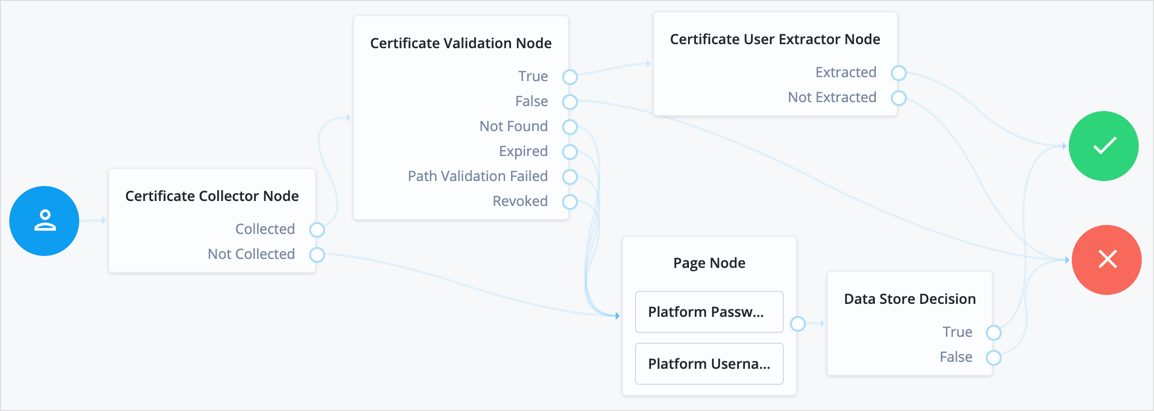Certificate Validation node
The Certificate Validation node validates a digital X.509 certificate collected by the Certificate Collector node.
Availability
| Product | Available? |
|---|---|
PingOne Advanced Identity Cloud |
No |
PingAM (self-managed) |
Yes |
Ping Identity Platform (self-managed) |
Yes |
Inputs
This node requires an X509Certificate property in the incoming node state.
Implement the Certificate Collector node as input to the Certificate Validation node.
Configuration
| Property | Usage |
|---|---|
Match Certificate in LDAP |
When enabled, AM matches the certificate collected with the one stored in an LDAP directory entry. You define the name of this entry and additional security-related properties later in the node configuration. Default: Disabled |
Check Certificate Expiration |
When enabled, AM checks whether the provided certificate has expired. Default: Disabled |
Subject DN Attribute Used to Search LDAP for Certificates |
The attribute that AM uses to search the LDAP directory for the certificate. The search filter is based on this attribute and the value of the Subject DN as it appears in the certificate. Default: |
Match Certificate to CRL |
When enabled, AM checks whether the certificate has been revoked according to a Certificate Revocation List (CRL) in the LDAP directory. Define related CRL properties later in the node configuration. Default: Disabled. |
Issuer DN Attribute(s) Used to Search LDAP for CRLs |
The name of the attribute or attributes in the issuer certificate that AM uses to locate the CRL in the LDAP directory.
Default: |
HTTP Parameters for CRL Update |
Parameters that AM includes in any HTTP CRL call to the CA that issued the certificate. If the client or CA certificate includes the Add the parameters as key-value pairs in a comma-separated list (,).
For example, |
Cache CRLs in Memory |
When enabled, AM caches CRLs in memory. If this option is enabled, Update CA CRLs from CRLDistributionPoint must also be enabled. Default: Enabled |
Update CA CRLs from CRLDistributionPoint |
When enabled, AM fetches new CA CRLs from the CRL Distribution Point and updates them in the LDAP directory.
If the CA certificate includes either the Default: Enabled |
OCSP Validation |
When enabled, AM checks the validity of certificates using the Online Certificate Status Protocol (OCSP). The AM instance must have internet access, and you must configure OSCP for AM under Configure > Server Defaults > Security > Online Certificate Status Protocol Check. Default: Disabled |
LDAP Server Where Certificates are Stored |
The LDAP server that holds certificates.
Enter the server details in the format To associate multiple AM servers in a site with corresponding LDAP servers, use the format |
LDAP Search Start or Base DN |
Valid base DN for the LDAP search, such as |
LDAP Server Authentication User and LDAP Server Authentication Password |
The credentials used to connect to the LDAP directory that holds the certificates. If you enable mTLS, the node ignores these credentials. Default Authentication User: |
mTLS Enabled |
Enables mTLS (mutual TLS) between AM and the directory server. When mTLS is enabled, the node ignores the values for LDAP Server Authentication User and LDAP Server Authentication Password. If you enable this property, you must:
Default: Disabled |
mTLS Secret Label Identifier |
An identifier used to create a secret label for mapping to the mTLS certificate in the secret store.
AM uses this identifier to create a specific secret label for this node.
The secret label takes the form For greater security, you should rotate certificates periodically. When you rotate a certificate, update the corresponding mapping in the realm secret store configuration to reflect this identifier. When you rotate a certificate, AM closes any existing connections using the old certificate. A new connection is selected from the connection pool and no server restart is required. |
Use SSL/TLS for LDAP Access |
When enabled, AM uses SSL/TLS to access the LDAP directory. Make sure that AM trusts the certificate from the LDAP server when enabling this option. Default: Disabled |
Outcomes
True-
The node could validate the certificate.
When the outcome is
True, add a Certificate User Extractor node to extract the values of the certificate. False-
The node couldn’t validate the certificate. The journey follows this path when the node can’t validate the certificate and no more specific outcome is available.
Not found-
The Match Certificate in LDAP property is enabled, but the certificate wasn’t found in the LDAP store.
Expired-
The Check Certificate Expiration property is enabled, and the certificate has expired.
Path Validation Failed-
The Match Certificate to CRL property is enabled, and the certificate path is invalid.
Revoked-
The OCSP Validation property is enabled, and the certificate has been revoked.
Example
The following is an example of how to use the certificate nodes in a Ping Identity Platform authentication journey. Note that all the failure outcomes of the Certificate Validation node are linked so that the user provides a username and password, but you could choose different authentication methods for each outcome:
